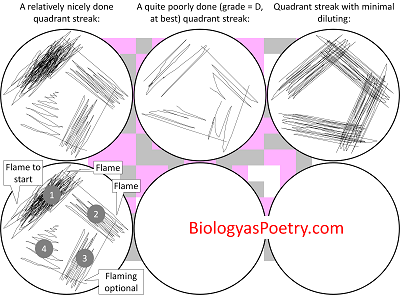∞ generated and posted on 2016.02.02 ∞
Isolation procedure of colonies on the surface of agar, employed to bring microorganisms into pure culture without external culture dilution.
The basic idea is to use repeated reductions in the number of organisms initiating a streak across an agar surface in combination with reductions in numbers of organisms that are streaked across the agar, together as a means of reducing bacterial densities down to isolated colony-forming units. The resulting isolated colonies can be assumed to have been formed from individual cells or cell arrangements and therefore to be clonal. Repeated streaking from a single, isolated colony, however, is typically employed to assure clonality, e.g., such as a total of three streak isolation procedures performed in serial (that is, rather than in parallel).
See also quadrant streak. By contrast, see pour-plate method or spread-plate method as isolation procedures. Isolation can also be performed in broth, which is the basis of the most probably number method (MPN).

Figure legend: Instructions for performing a quadrant streak, a common variation on the streak plate method.
Streak plates can be generated quite quickly (minutes or less), using minimal materials (a single plate/Petri dish), and a minimum of tools (inoculating loop and flame). The streak plate method also has the utility of avoiding explicit serial diluting. In short, the streak plate often is the first technique that a microbiologist performs starting with an environmental or clinical sample containing microorganisms.
Video (A variation on streaking for isolation into pure culture of bacterial colonies but also a good lesson on basic aseptic technique).